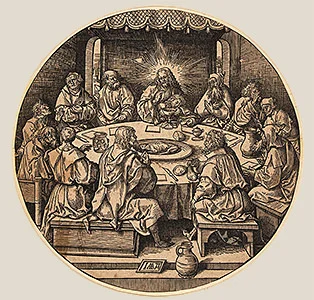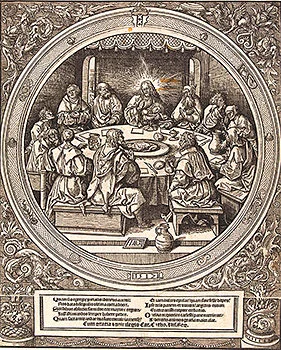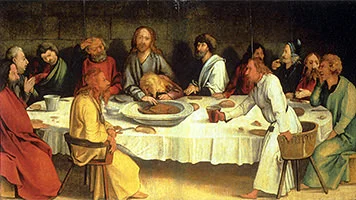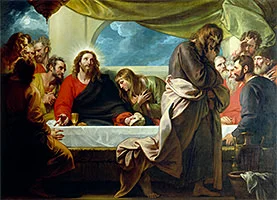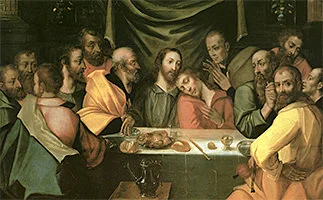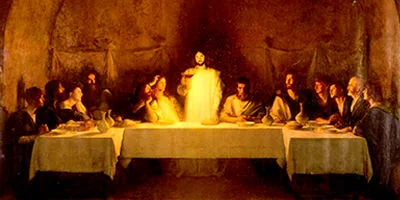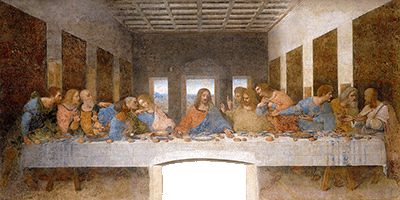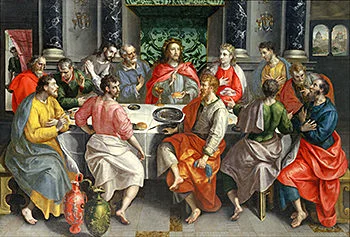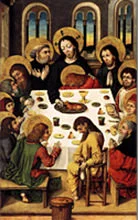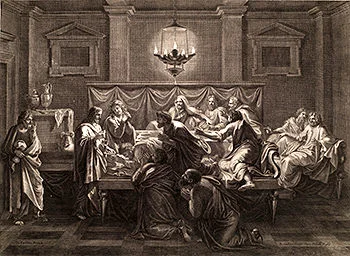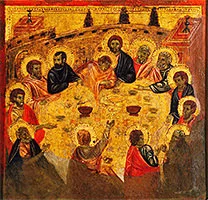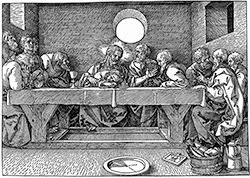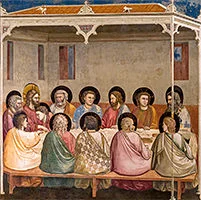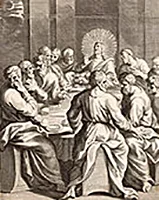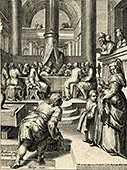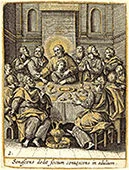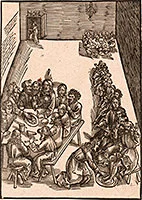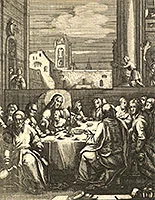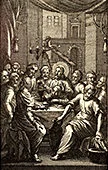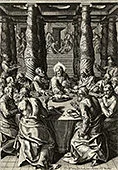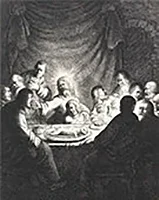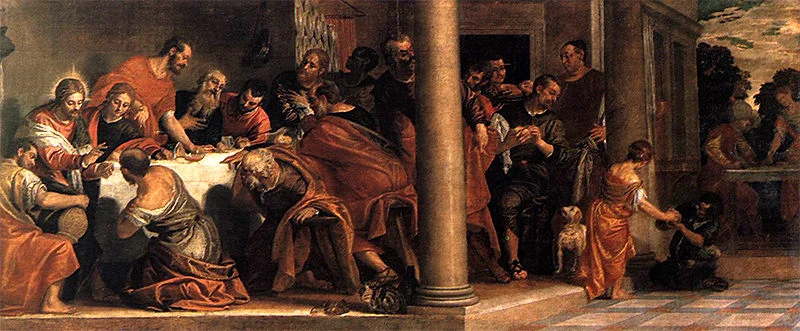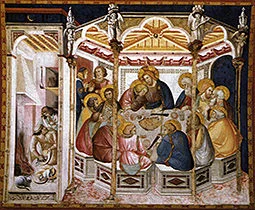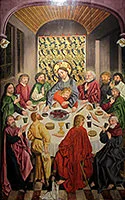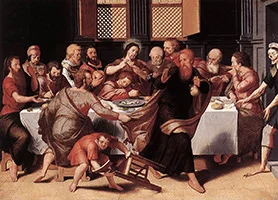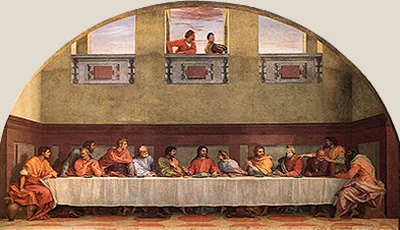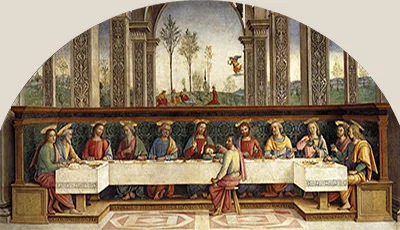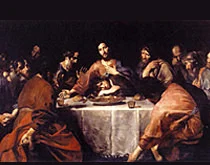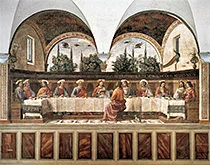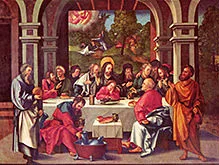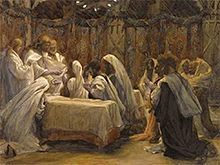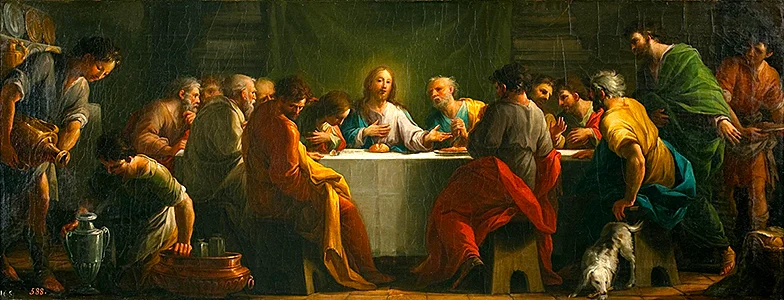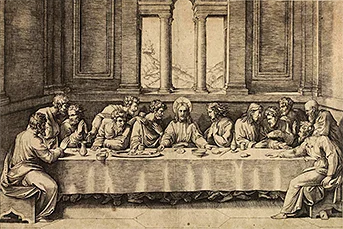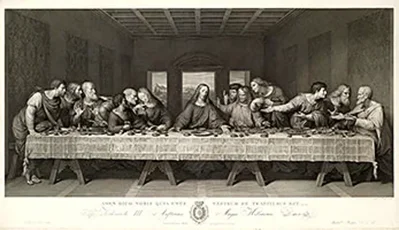The Art World Commemorates Peter
— Album 12 of 17 Photo Albums —
Warren Camp’s presentation of 550 famous “Peter” works of art includes historic paintings, frescoes, stained glass, etchings, sculptures, engravings, and other artwork monuments. They come from the Gothic (1100–1400), High Renaissance, Baroque, Rococo, Neoclassical, and Romantic (1800s) eras.
All are popular works, designed and created by celebrated artists, many of whom you’ll likely recognize, including Rembrandt, Raphael, Michelangelo, El Greco, Da Vinci, Masaccio, Huret, Galle, Tissot, Botticelli, Dürer, Rubens, and many more. They’ll bring back recollections of your “Art History 101” classes, using Janson’s History of Art textbook.
Whether depicting “Cephas,” “Petrus,” “Simon,” “Simeon,” “Simon Bar-Jonah,” “Simon Peter,” “The Rock,” “Peter,” “Apostle Peter,” or “Saint Peter,” the enlarged images of this acclaimed Bible figure come with factual and enlightening details: the artist’s bio; when each work was created; where it can be seen; applicable Bible passages; background and highlights of each work; and photo sources with copyright notices.
To appreciate the impact that Peter had on numerous art-world masters, be sure to click each thumbnail to enlarge it.
• These photo albums complement the Bible-study commentaries Warren has written for “1st and 2nd Peter,” found here.
…
Album 1 (Peter, alone) | Album 2 | Album 3 | Album 4 | Album 5
Album 6 | Album 7 | Album 8 | Album 9 | Album 10 | Album 11
Album 12 | Album 13 | Album 14 | Album 15 | Album 16 | Album 17
Album topics are shown at the [ ⇓ bottom ⇓ ] of each page.
Jesus’ Last Supper — Part 4 of 4
136 “Last Supper” Masterpieces in Four Photo Albums
Includes Giotto, Leonardo da Vinci, Giotto, Tissot, Veronese, Benjamin West, Perugino, Lützelmann, and more
Slide 22 — Click to enlarge and read its detailed caption.
Paolo Veronese, c. 1585, oil on canvas, Mannerism (Late Renaissance), Palazzo Brera, Milan, Italy
Slide 32 — click to enlarge.
Mariano Salvador Maella — c. 1794 — oil on canvas painting
- 1. “The Last Supper,” woodcut, by Jacob Cornelisz. van Oostsanen, 1511–1514, after Albrecht Dürer
Jacob Cornelisz. van Oostsanen (1470–1533) was known primarily for his woodcuts. “Around twenty-seven paintings and two hundred woodcuts are attributed to him. His graphic work is conventional in nature. He remained faithful to the Netherlandish tradition of small, highly detailed illustrations of a miniaturist type. In contrast, his paintings evolved over the course of his career: Early compositions are still late-Gothic in style, influenced by the Haarlem school; late work uses a much looser handling with simplified details and elongated proportions.”[1]
This Cornelisz roundel woodcut is from his Large Round Passion series of twelve woodcuts on laid paper with the frame cut away, first published in circular frames in 1514 in Amsterdam. He also produced a large number of large and small altarpieces, on commission and for the open market. [The next slide features a similar Jacob Cornelisz framed roundel woodcut.]
Above, we see in this circular design, titled The Last Supper, haloed Christ sitting at the head of a large round table with his disciples. He touches a wine goblet while John, the young beloved disciple, rests on his lap. Opposite Christ, Judas Iscariot (front-right) sits on a stool while holding his moneybag in his right hand. Judging by the disciples’ facial expressions and hand placement, Jesus has just told the Twelve: “Truly I tell you, one of you will betray me.” (Matthew 26:21). The entire biblical account of the Last Supper, which happened the night before Jesus Christ’s crucifixion, is found in these five New Testament passages: (Matthew 26:17–30; Mark 14:12–26; Luke 22:7–30; John 13:18–30; and 1 Cor. 11:23–26).
… Diameter: 9 3/4 in. (24.7 cm)
… Photo source, license, attribution, museum details, and image enlargement: National Gallery of Art; the Rosenwald Collection
… The artist’s short biography; his other works of art
Return to “Peter Masterpieces” album’s opening page or to the top of this page or open the next album.
- 2. “The Last Supper,” woodcut, by Jacob Cornelisz. van Oostsanen, 1511–1514, after Albrecht Dürer
This Jacob Cornelisz. van Oostsanen (1470–1533) woodcut differs from that which appears in the previous slide. While also a part of his Large Round Passion series of twelve woodcuts on laid paper, which presents Christ at the table with his twelve disciples, this roundel depiction comes with an elaborate ornamental frame having Latin text in its boxed footer. Its execution date — 1517 — is cut into the bottom of the circular border. Jacob Cornelisz was known primarily for his woodcuts and paintings. He also produced a large number of large and small altarpieces, on commission and for the open market. [The previous slide features a similar Jacob Cornelisz roundel woodcut without the custom frame.]
Above, we see in this circular design, titled The Last Supper, haloed Christ sitting at the head of a large round table with his disciples. He touches a wine goblet while John, the young beloved disciple, rests on his lap. Opposite Christ, Judas Iscariot (front-right) sits on a stool while holding a moneybag in his right hand. Judging by the disciples’ facial expressions and hand gestures, Jesus has just told the Twelve: “Truly I tell you, one of you will betray me.” (Matthew 26:21). The entire biblical account of the Last Supper, which happened the night before Jesus Christ’s crucifixion, is found in these five New Testament passages: (Matthew 26:17–30; Mark 14:12–26; Luke 22:7–30; John 13:18–30; and 1 Cor. 11:23–26).
An excellent video titled “Apostle Peter and the Last Supper” portrays Peter telling his story of Jesus to a young Roman guard; it includes a very detailed account of the Last Supper, which delivers a powerful “faith” message.
… Height: 13.7 in. (34.8 cm), width: 11.1 in. (28.1 cm)
… Photo source, license, attribution, museum details, and image enlargement: Rijksmuseum Amsterdam
… The artist’s short biography; his other works of art
Return to “Peter Masterpieces” album’s opening page or to the top of this page or open the next album.
- 3. “The Last Supper,” tempera on coniferous wood, painted by Matthais Grünewald, c. 1500
The Last Supper was painted by Matthais Grünewald (1480–1528). Born Mathis Gothart, he was a major figure in a generation of great northern German Renaissance painters who included Lucas Cranach and Albrecht Dürer. Grünewald remained relatively unknown until the 20th century; only about ten of his paintings and a few drawings survive. As a Protestant and a supporter of Martin Luther, Grünewald executed several commissions and was well known for painting religious scenes and altarpieces.
Herein we see Christ about to reveal which of his disciples will betray him. Looking closely at the facial expressions and hand gestures in Grünewald’s tempera-on-wood painting, the disciples’ responses emote feeling. Sitting to the left of Christ is Peter, the elderly disciple scratching his head. Sitting on Jesus’ lap, putting his head on the table, is young John. The disciples, having just heard Jesus say, “Truly I tell you, one of you will betray me” (Matthew 26:21), seem to fearfully wonder, “Could it be me, Lord, who’ll betray you?” In John’s gospel (13:18–30), “Jesus answered, ‘It is the one to whom I will give this piece of bread when I have dipped it in the dish.’ Then, dipping the piece of bread, he gave it to Judas, the son of Simon Iscariot. As soon as Judas took the bread, Satan entered into him” (vv. 26–27).
The biblical account of the Last Supper, which happened the night before Christ’s crucifixion, can be found in these five New Testament passages: (Matthew 26:17–30; Mark 14:12–26; Luke 22:7–30; John 13:18–30; and 1 Cor. 11:23–26).
… Height: 19 in. (48.5 cm), width: 33 1/2 in. (85.3 cm)
… Photo source, license, attribution, museum details, and image enlargement: Matthias Grünewald, public domain, via Wikimedia Commons
… The artist’s short biography; his other works of art
Return to “Peter Masterpieces” album’s opening page or to the top of this page or open the next album. - 4. “The Last Supper,” oil on canvas, painted by Benjamin West, 1786
Entirely self-taught, American artist Benjamin West (1738–1820), known in England as the “American Raphael,” was a British-American artist who often painted religious subjects. A close friend of Ben Franklin, he painted Franklin’s portrait. Incidentally, West had painted a prior oil-on-canvas painting of The Last Supper (1784, shown here,) which was disappointing to the Christian faithful, failing to convey the value and importance of the Last Supper account.
But this large, colorful, attention-getting, 1786 painted presentation of The Last Supper highlights key facets of this essential Bible account. Herein, West has glorified Jesus by giving him a radiant halo. Holding a half-cut loaf of bread, Christ looks upward to seek his Father’s presence at this most-difficult time. Peter leans close to Jesus’ right shoulder while young John, a beloved disciple (to the right of Jesus), leans endearingly to his Lord who has just told everyone that the betrayer is the one to whom Jesus will hand a morsel of bread. Jesus has handed it to Judas, holding his coin bag in his left hand as he stands and starts to leave the upper room. West has characterized Judas as having a dark, almost shady face with eyes that are aiming uncomfortably at the viewer.
Warren Camp compiled this detailed list of twenty-one sequential events surrounding the Last Supper. Each event, such as “Jesus Washes His Disciples’ Feet,” “The Disciples’ Sadness and Inquiry,” “Judas Identified as the Betrayer,” “Jesus Breaks Bread,” “Judas Leaves,” “Jesus Gives the Wine to His Disciples,” and “Departing the Upper Room,” is presented in the order in which it occurred; specific Bible verses are provided.
… Height: 8 ft. 2 in. (248.9 cm), width: 11 ft. 8 in. (356.9 cm)
… Photo source, license, attribution, museum details, and image enlargement: Benjamin West, public domain, via Wikimedia Commons
… The artist’s biography; his other works of art
Return to “Peter Masterpieces” album’s opening page or to the top of this page or open the next album. - 5. “The Last Supper,” oil on canvas, painted by Peter Candid, c. 1590
Peter de Witte, known in Italy as Pietro Candido and in Bavaria as Peter Candid (c. 1548–1628), was a Flemish-born Mannerist painter, tapestry designer, and draughtsman, active in Italy and Bavaria. He completed many frescoes and oil paintings in Italy. He painted this Last Supper when he lived and worked in Munich, Germany. The Flemish engraver, Jan Sadeler (1550–1560) created this copper-plate engraving after Candid’s painting.
Above, Candid retains traditional iconography in his painting: Christ and his disciples sit around a rectangular table filled with the Passover lamb, knives, bread, and wine cups; John, with closed eyes, rests his head on Christ’s left shoulder; Peter, close to Jesus’ right shoulder, reveals deep concern after hearing that his Lord is about to be betrayed; Judas, front-right, holding in his right hand the coin purse symbolic of his upcoming betrayal act, looks directly at the viewer. Judging by the disciples’ facial expressions, Jesus has just told the Twelve: “Truly I tell you, one of you will betray me” (Matthew. 26:21).
The entire biblical account of the Last Supper, which happened the night before Christ’s crucifixion, is found in these five New Testament passages: (Matt. 26:17–30; Mark 14:12–26; Luke 22:7–30; John 13:18–30; and 1 Cor. 11:23–26).
An excellent video titled “Apostle Peter and the Last Supper” portrays Peter, telling his story of Jesus to a young Roman guard; it includes a very detailed account of the Last Supper, which delivers a powerful “faith” message.
… Height: 8 ft. 2 in. (248.9 cm), width: 11 ft. 8 in. (356.9 cm)
… Photo source, attribution, museum details, and image enlargement: Art and the Bible
… The artist’s short biography; his other works of art
Return to “Peter Masterpieces” album’s opening page or to the top of this page or open the next album.
- 6. “The Lord’s Last Supper,” oil painting by Pascal Dagnan-Bouveret, 1896
The Lord’s Last Supper “At the Exposition Universelle of 1900, French painter Dagnan-Bouveret’s status as a respected artistic leader enabled him to showcase his paintings, including this huge painting in a separate installation on the fairgrounds. He based the composition of ‘The Lord’s Last Supper’ on Renaissance models, but the mystical lighting spotlights very contemporary French faces on the apostles. In November 1900, he was elected to the Académie des Beaux-Arts of the Institut de France: one of the youngest painters to receive this honor. Although often overwhelmed by the swift developments of modernism in the opening decades of the twentieth century, he continued to paint religious images, as well as portraits, until his death in 1929.”[1]
The “Eucharist” scene… While the first scene of Last Supper masterpieces of Western-Medieval art is the “Betrayal” scene in which we see the dramatic moment of Jesus announcing his upcoming betrayal, this painting depicts the second scene: the “Eucharist,” also known as Holy Communion and the Lord’s Supper. Jesus standing alone, holds up the wine cup in his right hand while placing his left hand on a bread loaf. The first epistle that Apostle Paul wrote to the Corinthian church body contains the earliest known mention of the Last Supper: “The Lord Jesus, on the night he was betrayed, took bread, and when he had given thanks, he broke it and said, ‘This is my body, which is for you; do this in remembrance of me.’ In the same way, after supper he took the cup, saying, ‘This cup is the new covenant in my blood; do this, whenever you drink it, in remembrance of me.’ For whenever you eat this bread and drink this cup, you proclaim the Lord’s death until he comes” (1 Cor. 11:23–26 NIV).”
… Framed height: 16.9 in. (43 cm), width: 20.4 in. (52 cm)
… Photo source, license, attribution, museum details, and image enlargement: Pascal Dagnan-Bouveret, public domain, via Wikimedia Commons
… The artist’s short biography; his other works of art
Return to “Peter Masterpieces” album’s opening page or to the top of this page or open the next album. - 7. A Masterpiece of the Italian High Renaissance — One of the Best-Known Works of Christian Art
Leonardo da Vinci’s “The Last Supper” illustrates the scene from the last days of Jesus Christ, as described in Apostle John’s gospel. After washing his disciples’ feet, Jesus began to predict his upcoming betrayal: “Very truly I tell you, one of you is going to betray me” (John 13:21). The painting portrays the reaction of each disciple after hearing this news. Flanked by his Twelve [each identified in this photo], Jesus, looking troubled, opens his left hand toward the bread and his right hand toward the wine bowl that’s in front of Judas, the one grasping a bag of silver coins in his right hand.
Apostle John tells us that he leaned back against Jesus, asking him: “Lord, who is it?” Jesus answered, “It is the one to whom I will give this piece of bread when I have dipped it in the dish.” Then, dipping the piece of bread, he gave it to Judas, the son of Simon Iscariot. As soon as Judas took the bread, Satan entered into him” (John 13:26–27 NIV).”
Da Vinci took three years to complete this mural using experimental pigments applied directly to a dry-plaster wall, unlike usually painted wet-plaster frescoes. Sadly, aside from natural decay, this fresco became a victim of neglect and abuse. In 1652, monastery residents cut a new doorway on the wall of this already deteriorating painting, removing Jesus’ feet. Late in the 18th century, Napoleon Bonaparte’s soldiers turned the area into a stable, further damaging the fresco. And during World War II, the Nazis bombed the monastery, reducing surrounding walls to rubble and dust.
Note: Behind Judas, Peter holds a symbolic dagger in his right hand. Watch this 7-minute video clip that describes and highlights Leonardo’s masterpiece.
… Height: 15 ft. 1 in. (460 cm), width: 28 ft. 10 in. (880 cm)
… Photo source, license, attribution, museum details, and image enlargement: Leonardo da Vinci, public domain, via Wikimedia Commons
… The artist’s short biography; his other works of art
Return to “Peter Masterpieces” album’s opening page or to the top of this page or open the next album.
- 8. “The Last Supper,” oil on canvas, painted by Maerten de Vos, undated
Maerten de Vos (1532–1603) was principally a Flemish painter of religious scenes. A prolific draughtsman, he produced numerous designs for Antwerp printers. His designs were also used as models for tapestries and stained-glass windows.
In this Last Supper, “Christ sits at the center of the far side of the table, with his disciples arrayed around him. When he announced that one among them would betray him, his disciples reacted visibly. This painting depicts that specific reactionary instant. De Vos arranged the disciples in small groups, ably isolating Judas the betrayer. While all the other disciples are either looking at Christ or are talking amongst themselves (note the one exception, looking out at the viewer, which is a compositional device), it is only Judas, placed directly in front of Christ, who turns strategically to the side to avoid Christ’s gaze.”[1]
Warren Camp has compiled this list of twenty-one sequential events leading up to and following the Last Supper. Each event, such as “Preparation of the Passover Meal,” “Jesus Sits at the Dinner Table with His Disciples,” “He Washes His Disciples’ Feet,” “Jesus Predicts His Betrayal,” “The Disciples’ Sadness and Inquiry,” “Judas Identified as the Betrayer,” “The Fate of the Betrayer,” “Jesus Breaks Bread and Gives It to Them,” “Judas Leaves,” “Jesus Gives the Wine to His Disciples,” “Departing the Upper Room,” “On Route to the Mount of Olives,” and so on, is presented in the order in which it occurred; specific Bible references are provided.
… Height: 57.5 in. (146 cm), width: 83.7 in. (212.5 cm)
… Photo source, license, attribution, museum details, and image enlargement: Maerten de Vos, public domain, via Wikimedia Commons
… The artist’s short biography; his other works of art
Return to “Peter Masterpieces” album’s opening page or to the top of this page or open the next album. - 9. “The Last Supper,” oil on oak panel, painted by Master of the Housebook, 1475–1480
Master of the Housebook (active 1475–11490) “The Master of the Housebook was a witty, animated artist known from a series of courtly sketches. His The Last Supper, part of the Passion Altarpiece (c. 1475), is seen in old-fashioned perspective, with the figures in the foreground smaller than those at the far end of the table. It includes the traditional group of Christ comforting young John, who is so overcome by learning of Jesus’ betrayal that he buries his head in Christ’s lap. Judas, in the foreground, consoles himself by weighing his purse that held the payment he received for the Lord’s upcoming betrayal.”[1]
In addition to this Last Supper painting, the Housebook Master also painted Christ Washes Peter’s Feet, shown on Album 8, slide 23, of Warren Camp’s “Peter Masterpieces” photo collection.
Who was Judas Iscariot? “Typically remembered for his betrayal of Jesus, Judas was one of the Twelve who lived with and followed Jesus for three years, witnessing Jesus’ ministry, teaching, and many miracles. He was the group treasurer and used this trusted position to steal from their resources (John 12:6). As a thief, according to Matthew 26:14–15, the chief priests paid him “thirty pieces of silver” to betray the Lord. Given his close proximity to Jesus during three years of ministry, it’s hard to imagine how he could follow through on such a dastardly betrayal.”[2]
… Height: 51 1/2 in. (131 cm), width: 29 7/8 in. (76 cm)
… Photo source, license, attribution, museum details, and image enlargement: Master of the Housebook, public domain, via Wikimedia Commons
… The artist’s short biography; his other works of art
Return to “Peter Masterpieces” album’s opening page or to the top of this page or open the next album. - 10. “The Last Supper,” engraved etching, by Benoît Audran the Elder, 1671–1721
A notable French engraver, Benoît Audran the Elder (1661–1721), “received his first instruction in the art of engraving from his father, Germain, but had afterwards the advantage of studying under his uncle, the celebrated Gérard Audran. Benoît was received into the Académie des Beaux-Arts in 1709 and appointed engraver to King Louis XIV.[1] This Last Supper engraving was designed and printed after a Claude Audran II painting, as noted.
A candlelight chandelier drops light on this attention-getting presentation of the Last Supper. The artist highlights key facets of this essential Bible account. Herein, Benoît Audran I has well-lit Jesus standing at the left end of a dining stool. Holding in his left hand a tray of bread pieces and a wine goblet, Jesus lifts up in his other hand one piece of bread that he’ll give to Judas Iscariot who stands behind him at this most-difficult time. Judas, holding his coin bag in one hand raises the other hand in an expression of discomfort. He’s about to leave the upper room.
What’s important about Judas? “Typically remembered for his betrayal of Jesus, Judas was one of the Twelve who lived with and followed Jesus for three years, witnessing Jesus’ ministry, teaching, and many miracles. He was the group treasurer and used this trusted position to steal from their resources (John 12:6). As a thief, according to Matthew 26:14–15, the chief priests paid him “thirty pieces of silver” to betray the Lord. Given his close proximity to Jesus during three years of ministry, it’s hard to imagine how he could follow through on such a dastardly betrayal.”[2]
… Height: 19 1/4 in. (48.9 cm), width: 24 1/2 in. (62 cm)
… Photo source, license, attribution, museum details, and image enlargement: Rijksmuseum Amsterdam
… The artist’s short biography… See hundreds more Last Supper artwork varieties on this page; find numerous Last Supper engraved prints.
Return to “Peter Masterpieces” album’s opening page or to the top of this page or open the next album. - 11. “The Last Supper,” tempera and gold leaf on panel, painted by an unknown artist, c. 1280
This Last Supper painting is part of “The Life of Christ,” which is “a series of five tempera-and-gold-on-panel paintings (shown here) depicting scenes from the Life of Christ. The works date c. 1290–1300 and are attributed either to the circle of Cimabue or to a Venetian artist.”[1]
While the first scene of Last Supper masterpieces of Late-Gothic art is the “Betrayal” scene, when we see the dramatic moment when Jesus announced his upcoming betrayal, this painting depicts the second scene: the “Eucharist” scene, also known as Holy Communion and the Lord’s Supper. It was the final meal that Jesus would share with his followers — his twelve haloed apostles — before he was crucified. Young Apostle John, at Christ’s right, leans forward to accept a piece of broken bread, representing Christ’s broken body. Interestingly, following Byzantine traditions of Crete, the artist placed this dinner scene at a round table, while later Italian-Renaissance depictions seat the figures at a rectangular table, in favor of symmetry and clarity.
The first epistle that Apostle Paul wrote to the Corinthian church body contains the earliest known mention of the Last Supper: “The Lord Jesus, on the night he was betrayed, took bread, and when he had given thanks, he broke it and said, ‘This is my body, which is for you; do this in remembrance of me.’ In the same way, after supper he took the cup, saying, ‘This cup is the new covenant in my blood; do this, whenever you drink it, in remembrance of me.’ For whenever you eat this bread and drink this cup, you proclaim the Lord’s death until he comes” (1 Cor. 11:23–26 NIV).”
… Framed height: 6 3/4 in. (17 cm), width: 7 1/8 in. (18 cm)
… Photo source, public domain license, attribution, museum details, and image enlargement: Samuel H Kress Foundation
Return to “Peter Masterpieces” album’s opening page or to the top of this page or open the next album. - 12. “The Last Supper,” woodcut print by Albrecht Dürer, 1523
German artist Albrecht Dürer’s “The Last Supper” woodcut of 1523 is one of the last pieces of artwork crafted by him in his lifetime. It’s also one of the most famous themes in religious art, which is why Warren Camp’s “Peter Masterpieces” photo album includes 132 superb Last Supper specimens in four albums. Numerous artists have presented Christ’s Last Supper in a variety of ways.
But, “Dürer altered the central focus of the Last Supper story. Rather than conveying Christ about to tell his disciples that one of the twelve would betray him, the print takes things to another step. It shows only eleven disciples, meaning that the betraying disciple, Judas, has already left. Christ, at the center, directs the remaining eleven to continue spreading their faith, even after his crucifixion. Besides, he tells them that they’ll be recognized for how they’ll love one another. Typically, the scene originates from the biblical teachings of Apostle John: ‘A new command I give you: Love one another. As I have loved you, so you must love one another. By this everyone will know that you are my disciples, if you love one another’ (John 13:34–35).”[1]
What happened in the upper room during the Last Supper? “The events that occurred in the “upper room” are described in Matthew 26:1–29, Mark 14:12–25, Luke 22:7–20, and John 13:1–38. During the last hours that Jesus spent with His beloved friends, He ate with them, instituted the New Covenant in His blood, gave them last-minute instructions and encouragement, and prayed His “high priestly prayer” over them.”[2]
… Height: 5 3/4 in. (14.6 cm), width: 8 3/8 in. (21.3 cm)
… Photo source, license, attribution, museum details, and image enlargement: The Met; the Rogers Fund, 1922
… The artist’s short biography; his other works of art; Dürer’s collection of thirty-six “Small Passion” woodcuts and twelve “Large Passion” woodcuts
Return to “Peter Masterpieces” album’s opening page or to the top of this page or open the next album. - 13. “The Last Supper,” fresco, painted by Giotto, 1304–1306
Giotto di Bondone (1266–1337), “known mononymously as Giotto, was an Italian painter and architect from Florence during the Late Middle Ages. He worked during the Gothic/Proto-Renaissance period.”[1]
Giotto’s Last Supper fresco deviates from the purely Eucharistic interpretation of the event. This depiction presents the human drama that arose when Christ proclaimed his upcoming betrayal. While twelve black-haloed disciples sit on both sides of a long, rectangular dinner table, Jesus sits at its left end, not traditionally at the center. John, a beloved disciple, closes his eyes and leans close to Jesus’ chest. Interestingly, the artist hasn’t placed food, wine, or utensils on the table. However, painted in warm tones of yellow-orange and purple, the setting is discreet and refined, which is a characteristic of Giotto’s style.
Here are the Scriptures that document details of the Last Supper: Matt. 26:17–30, Mark 14:12–32; Luke 22:7–38; John 13:2–38. Warren Camp has compiled this list of twenty-one sequential events leading up to and following the Last Supper. Each event, such as “Jesus Washes His Disciples’ Feet,” “Judas Identified as the Betrayer,” and “Departing the Upper Room,” is presented in the order in which it occurred; specific Bible verses are provided.
This excellent video — “Apostle Peter and the Last Supper” — portrays Peter, telling his story of Jesus to a young Roman guard; it includes a very detailed account of the Last Supper, which delivers a powerful “faith” message.
… Height: 78.7 in. (200 cm), width: 72.8 in. (185 cm)
… Photo source, license, attribution, museum details, and image enlargement: Giotto, public domain, via Wikimedia Commons
… The artist’s short biography; his other works of art
Return to “Peter Masterpieces” album’s opening page or to the top of this page or open the next album.
- 14. “The Last Supper,” engraved print, by Benoît Thiboust, 1629–1719
Very little information is available about the life and history of Benoît Thiboust, a Belgian engraver (1660–1719).
This Last Supper engraving follows a traditional compositional formula: Christ, wearing a radiant halo as he looks upward, is in the center of the artwork. He and the Twelve sit at a rectangular dinner table; young John rests his head on the table while older Peter is at the Lord’s right hand; the apostles are barefoot because Jesus had already humbled himself by washing each man’s feet; Judas, front-left, holding his coin purse in his left hand, intentionally turns his head away from Jesus.
Thiboust’s print presents the moment when Jesus declared that one of his apostles with him at the dinner table would betray him that evening. In Matthew’s gospel, we learn the exact words of warning that Jesus spoke to them: 21“And while they were eating, he said, ‘Truly I tell you, one of you will betray me.’ 22They were very sad and began to say to him one after the other, ‘Surely you don’t mean me, Lord?’ 23Jesus replied, ‘The one who has dipped his hand into the bowl with me will betray me. 24The Son of Man will go just as it is written about him. But woe to that man who betrays the Son of Man! It would be better for him if he had not been born.” (Matt. 26:21).
See hundreds more Last Supper artwork varieties from Rijksmuseum Amsterdam in addition to its numerous Last Supper engraved prints.
… Height: 8.3 in. (210 mm), width: 6.6 in. (168 mm)
… Photo source, license, attribution, museum details, and image enlargement: Rijksmuseum Amsterdam
… The artist’s biography could not be located; you can see his other works of art
Return to “Peter Masterpieces” album’s opening page or to the top of this page or open the next album. - 15. “The Last Supper,” engraved print, by Zacharias Dolendo, 1596–1598, after Karel van Mander
Little is known about Zacharias Dolendo (1561–1601), a Dutch reproductive engraver, printer, and draftsman who worked in Leiden, Netherlands.
This Last Supper “Passion of Christ” (series title) engraving is from a series of thirteen prints, plus a title print, created by Dolendo and published by Jacques de Gheyn II (mentioned on object). It follows a traditional compositional formula: Christ, centered at the rear of the artwork, sits with his Twelve around a dinner table in a large pavilion, during a supper that was catered and observed by many; young John rests his head on Christ’s chest while older Peter is at the Lord’s right hand; the apostles are barefoot because Jesus had already humbled himself by washing each man’s feet; Judas, front-left at the table, holding his coin purse in his right hand, intentionally turns his head away from Jesus and prepares to depart the room.
Warren’s list of the Last Supper’s twenty-one sequential events includeing “Jesus Washes His Disciples’ Feet,” “Judas Identified as the Betrayer,” “The Fate of the Betrayer,” and “Judas Leaves.” All are presented in the order in which it occurred scripturally; specific Bible verses are provided.
See hundreds more Last Supper artwork varieties on this page; find numerous Last Supper engraved prints.
… Height: 6 in. (150 mm), width: 4 in. (102 mm)
… Photo source, license, attribution, museum details, and image enlargement: The British Museum
… The artist’s biography could not be located; you can see his other works of art
Return to “Peter Masterpieces” album’s opening page or to the top of this page or open the next album. - 16. “The Last Supper,” plate 2 of 24, engraved by Adriaen Collaert, c. 1580–c. 1590, after Maarten de Vos
Adriaen Collaert (1560–1618) was a Flemish designer, engraver, and pupil of Pieter de Vos. A member of a family of reproductive engravers working in Antwerp during the 16th and 17th centuries, Collaert was a print publisher, book illustrator, and reproductive engraver.
This small engraved print (plate 2.) on paper is part of Collaert’s “Passion of Christ” series found it in a print album of engravings with scenes from the life and passion of Christ. This Last Supper engraving was heightened by the artist with metallic gold and silver. The second series was also probably designed by Adriaen Collaert, following several series of prints after Maarten de Vos’s designs [see slide 8 of this album].
The artist retains traditional iconography in his engraving: Christ and his disciples sit at a rectangular table filled with the Passover lamb, knives, bread, and wine cups; John, with closed eyes, rests on Christ’s lap; Peter, close to Jesus’ right arm, reveals deep concern after hearing that his Lord will be betrayed; Judas, front-left, holding in his coin purse, symbolic of his upcoming betrayal act, looks directly at Jesus who hands Judas a dipped piece of bread that identifies him as the betrayer. Judging by the disciples’ facial expressions, Jesus has just told the Twelve: “Truly I tell you, one of you will betray me” (Matthew 26:21–24).
See hundreds more Last Supper artwork varieties on this page; find numerous Last Supper engraved prints.
… Height: 3.3 in. (85 mm), width: 2.6 in. (66 mm)
… Photo source, license, attribution, museum details, and image enlargement: Rijksmuseum Amsterdam; purchased with support of F.G. Waller-Fonds
… The artist’s short biography; his other works of art
Return to “Peter Masterpieces” album’s opening page or to the top of this page or open the next album. - 17. “The Last Supper and Foot Washing,” woodcut on paper, by an anonymous artist,1506, after Urs Graf the Elder
This woodcut by an anonymous artist was designed after that of Urs Graf, a Swiss Renaissance goldsmith, painter, and printmaker. The unique presentation combines Jesus’ foot washing account (right side), followed by his Last Supper (left side and right-rear). Judas Iscariot leaves the room (back-left).
In the Last Supper element of this woodcut, haloed Christ sits at the table with his Twelve. He’s just told them: “Truly I tell you, one of you will betray me.” (Matthew 26:21). His left hand will give a piece of bread to Judas (third man to Jesus’ right) who, holding a coin purse in hand, extends his right hand to accept Christ’s bread offering. In John’s gospel (13:18–30), we learn the identity of Christ’s betrayer: “Jesus answered, ‘It is the one to whom I will give this piece of bread when I have dipped it in the dish.’ Then, dipping the piece of bread, he gave it to Judas, the son of Simon Iscariot. As soon as Judas took the bread, Satan entered into him” (vv. 26–27).
The Foot Washing element of this woodcut (front-right) presents haloed Christ, washing first the feet of Apostle Peter who raises both arms in submission. Because the foot-washing event occurred prior to the Last Supper, we find all Twelve preparing to have their feet washed by the Lord Jesus. Warren Camp has compiled this list of twenty-one sequential events leading up to and following the Last Supper. Each event, such as “Jesus Washes His Disciples’ Feet,” “Judas Identified as the Betrayer,” and “Judas Leaves,” is presented in the order in which it occurred; specific Bible verses are provided. The entire biblical account of the Last Supper, which happened the night before Christ’s crucifixion, is found in these five New Testament passages: (Matthew 26:17–30; Mark 14:12–26; Luke 22:7–30; John 13:18–30; and 1 Cor. 11:23–26).
… Height: 8.7 in. (220 mm), width: 6.1 in. (156 mm)
… Photo source, license, attribution, museum details, and image enlargement: Rijksmuseum Amsterdam
Return to “Peter Masterpieces” album’s opening page or to the top of this page or open the next album. - 18. “The Last Supper,” etching by Nicolas Cochin, mid-17th century
Nicolas Cochin was born in Paris where he studied engraving and rose quickly to success and fame.
Cochin’s depiction of The Last Supper shows the Twelve sitting with Jesus around a rectangular dinner table with a tablecloth. Traditionally, young John, “the disciple whom Jesus loved” (John 13:23), is seen herein leaning on or lying in front of haloed Christ’s chest, asleep or simply resting. The artist appears to have given John added emphasis, putting him near the center of this etching, between Jesus above him and Judas Iscariot directly opposite Jesus. In his left hand, Judas (front-right) traditionally holds his moneybag out of sight. Cochin has Judas staring at a disciple to his left in a somewhat confrontational manner.
The biblical account of the Last Supper, which happened the night before Christ’s crucifixion, is found in these five New Testament passages: Matt. 26:17–30, Mark 14:12–32; Luke 22:7–38; John 13:2–38. Warren Camp has compiled this list of twenty-one sequential events leading up to and following the Last Supper. Each event, such as “Jesus Washes His Disciples’ Feet,” “Judas Identified as the Betrayer,” “The Fate of the Betrayer,” “Judas Leaves,” “Jesus Gives the Wine to His Disciples,” and “Departing the Upper Room,” is presented in the order in which it occurred; specific Bible references are provided.
Watch and enjoy an excellent video — “Apostle Peter and the Last Supper” — that portrays Peter, telling his story of Jesus to a young Roman guard; it includes a very detailed account of the Last Supper, which delivers a powerful “faith” message.
… Height: 5 3/8 in. (13.6 cm), width: 7 13/16 in. (19.8 cm)
… Photo source, license, attribution, and image enlargement: The Met; the Elisha Whittelsey Collection, the Elisha Whittelsey Fund, 1951
… The artist’s biography could not be found.
Return to “Peter Masterpieces” album’s opening page or to the top of this page or open the next album.
- 19. “The Last Supper,” engraved etching, by Wenceslaus Hollar, 1670
Wenceslaus Hollar (1607–1677) was a prolific and accomplished 17th-century Bohemian graphic artist. “He was one of the most skilled etchers of his or any other time, which is all the more remarkable given that he was almost blind in one eye. By his life’s end, he’d produced about 2,700 unique etchings.[1]
Surrounded by his disciples, haloed Christ sits centered at his Last Supper dinner table. In the background, a servant comes down a stairway to bring the main dish: the Passover lamb. Jesus, holding a piece of bread in his right hand over a goblet of wine, is about to give the bread to Judas who sits opposite the Lord, looking directly at Judas as he turns his face away. Holding his purse in his right hand, he appears to be ready to get up and leave the room.
What do we know of Judas Iscariot? “Typically remembered for his betrayal of Jesus, Judas was one of the Twelve who lived with and followed Jesus for three years, witnessing Jesus’ ministry, teaching, and many miracles. He was the group treasurer and used this trusted position to steal from their resources (John 12:6). As a thief, according to Matthew 26:14–15, the chief priests paid him “thirty pieces of silver” to betray the Lord. Given his close proximity to Jesus during three years of ministry, it’s hard to imagine how he could follow through on such a dastardly betrayal.”[2]
This excellent video titled “Apostle Peter and the Last Supper” portrays Peter, telling his story of Jesus to a young Roman guard; it includes a very detailed account of the Last Supper, which delivers a powerful “faith” message.
… Height: 5 1/2 in. (14 cm), width: 3 1/8 in. (8 cm)
… Photo source, license, attribution, museum details, and image enlargement: Wenceslaus Hollar, public domain, via Wikimedia Commons
… The artist’s short biography his other works of art
Return to “Peter Masterpieces” album’s opening page or to the top of this page or open the next album.
- 20. “The Last Supper,” engraving, by Cornelis Cort, 1578, after Livio Agresti
Cornelis Cort (1533–1578), “was a Dutch engraver and draughtsman. He spent his last 12 years in Italy, where he was known as Cornelio Fiammingo.”[1]
The engraver intentionally included in the background, behind the colonaides, the previous Last Supper scene in which Jesus washed all of his apostles’ feet (shown here). Note: Warren Camp has compiled this list of twenty-one sequential events leading up to and following the Last Supper. Each event, such as “Jesus Washes His Disciples’ Feet,” “Judas Identified as the Betrayer,” “Jesus Breaks Bread,” “Judas Leaves,” “Jesus Gives the Wine to His Disciples,” and “Departing the Upper Room,” is presented in the order in which it occurred; specific Bible verses are provided.
In his Last Supper, Cort has put Christ inside a room with twisted columns, sitting with his apostles at a round table during his last supper. Centered, wearing a brilliant halo, Christ puts his left hand on young John’s head and his other hand on the Passover lamb that fills a bowl at the table’s center. Peter and Christ look into one another’s eyes while Judas Iscariot (front-right), holding a coin purse in his left hand, looks toward the viewer most uncomfortably.
Here are the Scriptures that document a variety of details of the Last Supper: Matthew 26:17–30, Mark 14:12–32; Luke 22:7–38; John 13:2–38.
… Height: 1 ft. 9 in. (531 mm), width: 1 ft. 2 in. (356 mm)
… Photo source, license, attribution, museum details, and image enlargement: Cornelis Cort, public domain, via Rijksmuseum Amsterdam
… The artist’s short biography; his other works of art
Return to “Peter Masterpieces” album’s opening page or to the top of this page or open the next album. - 21. “The Last Supper,” etching, by Jan Gillisz. van Vliet, 1628–1637
Jan Gillisz. van Vliet (1605–1668), “was a Dutch Golden Age painter who worked from Vliet, Utrecht, Netherlands. Born in Leiden where he became a Rembrandt pupil, his paintings are no longer attributed to him with any certainty. Today he is known only for his drawings and prints.”[1]
This Last Supper etching depicts the exact moment when Jesus identified Judas Iscariot as the betrayer, when he gave Judas a piece of dipped bread.
Without using candles as the usual light source for a supper scene, the artist instead masterfully and dramatically lit everyone at the dinner table, including the Passover lamb that was presented on a platter. In this attention-getting presentation of the Last Supper, Gillisz highlights key facets of this essential Bible account. We learn in John’s gospel that “Jesus was troubled in spirit and testified, ‘Very truly I tell you, one of you is going to betray me’ (John 13:21). At a loss to know which of them he meant, his disciples stared at one another until young John leaned back against Jesus and asked him who the betrayer was. “Jesus answered, ‘It is the one to whom I will give this piece of bread when I have dipped it in the dish.’ Then, dipping the piece of bread, he gave it to Judas, the son of Simon Iscariot” (v. 26).
See hundreds more Last Supper artwork varieties from Rijksmuseum Amsterdam in addition to its numerous Last Supper engraved prints.
… Height: 8.4 in. (213 mm), width: 6.7 in. (169 mm)
… Photo source, license, attribution, museum details, and image enlargement: Rijksmuseum Amsterdam
… The artist’s short biography; his other works of art
Return to “Peter Masterpieces” album’s opening page or to the top of this page or open the next album. - 22. “The Last Supper,” oil on canvas, painted by Paolo Veronese, c. 1585
Paolo Veronese’s “The Last Supper” “The artist belonged to a circle of influential and important painters in sixteenth-century Venice. Born Paolo Caliari, he became known as “Veronese” after his birthplace, Verona. At the age of fourteen, Veronese was apprenticed to an established Venetian painter, but he was more influenced by the monumental works of Raphael and Michelangelo. He arrived in Venice at the age of twenty-five and spent the rest of his lifetime there, painting altarpieces and decorative cycles in chapels and palaces.”[1]
“In the eighties, Paolo returned to the theme of the Lord’s Supper in this canvas (c.1585) for the Venetian church of Santa Sofia, where it was until 1811 but now is in Pinacoteca di Brera, Milan. Here the painter substantially modified the compositional structure he had adopted in the past for similar pictures. In particular, he changed the location of Christ, who no longer dominates the center of the scene but is placed on the left-hand edge of the canvas. In addition, the long table is now set diagonally instead of being viewed from the front. And, the triumphant architectural setting of the feasts he painted in the sixties and seventies has vanished completely; the event now takes place in modest surroundings, emphasizing Christ’s message of humility and poverty.”[2]
Watch and enjoy this excellent video — “Apostle Peter and the Last Supper” — that portrays Peter, telling his story of Jesus to a young Roman guard; it includes a very detailed account of the Last Supper, which delivers a powerful “faith” message.
… Height: 7.2 ft. (220 cm), width: 17.2 ft. (523 cm)
… Photo source, license, attribution, and image enlargement: public domain via Web Gallery of Art; Pinacoteca di Brera, Milan
… The artist’s short biography; his other works of art
Return to “Peter Masterpieces” album’s opening page or to the top of this page or open the next album. - 23. “The Last Supper,” fresco, painted by Pietro Lorenzetti, c. 1320
Pietro Lorenzetti (or Pietro Laurati, c. 1280–1348) “was an Italian painter, active between c.1306 and 1345. Little is known of his life. Many of his religious works may still be seen in churches and museums in the Tuscan towns of Arezzo, Assisi, and Siena.
“Lorenzetti’s Last Supper has Christ and his disciples seated around an awkwardly angled table, within a brightly shining rotunda, under a night sky festooned with shooting stars and a crescent moon. To the left of the holy diners is a narrow kitchen; in it is a man doing dishes, a woman at his shoulder, a dog licking the last scraps from a plate, and a cat asleep.”[1] The artist adds a richly decorated pavilion with a complicated hexagonal ceiling and sculpted angels. His cat may have inspired Ghirlandaio to include a cat in his subsequent 1486 Last Supper painting, which you’ll see on slide 27 of this album.
Above, the Sienese painter retains traditional iconography in this 14th-century painting: Christ and his disciples sit around a dinner table filled with knives, bread, and wine cups; young John, with closed eyes, rests his head on Christ’s right shoulder; Peter, on Jesus’ other side, shows concern after hearing that his Lord is about to be betrayed; Judas, front-left, sitting without a halo, looks directly at Jesus who is handing him the piece of bread that identifies him as Christ’s betrayer, as is revealed in John’s eyewitness gospel account: John 13:25–27.
… Dimensions not provided
… Photo source, license, attribution, museum details, and image enlargement: Pietro Lorenzetti, public domain, via Wikimedia Commons
… The artist’s short biography; his other works of art
Return to “Peter Masterpieces” album’s opening page or to the top of this page or open the next album. - 24. “The Last Supper,” oil on panel, painted by Heinrich Lützelmann, 1485
This is one in a collection of ten late-15th-century “Passion of Christ” paintings by Heinrich Lützelmann. They’re “Gothic religious paintings now displayed in the choir of the Catholic part of Old Saint Peter’s Church in Strasbourg, France. The set was classified as a Monument Historique by the French Ministry of Culture in 1978. The oil-on-panel paintings depict selected scenes from the Passion of Christ. The artist is generally thought to be one Heinrich Lützelmann. According to some scholars, he may be identical with the anonymous Master of the Drapery Studies.”[1] See Lützelmann’s ten Passion of Christ paintings depicting the short final period in the life of Jesus Christ.
Above, in Lützelmann’s Last Supper painting, Christ has been given a larger face than all of his disciples. He also has a magnificent halo while eleven of the Twelve have smaller radiant halos; Judas Iscariot is the only disciple without a halo. Looking closely, Jesus is dipping a piece of bread in a dish immediately in front of Judas who sits (front-left) on a stool while wearing a coin purse on his belt. Judging by the disciples’ facial expressions and hands placement, Jesus has just told the Twelve: “Truly I tell you, one of you will betray me.” (Matthew 26:21). When the disciples asked who might betray their Lord, “Jesus answered, “It is the one to whom I will give this piece of bread when I have dipped it in the dish.” Then, dipping the piece of bread, he gave it to Judas, the son of Simon Iscariot. As soon as Judas took the bread, Satan entered into him” (John 13:26–27 NIV). The entire biblical account of the Last Supper, which happened the night before Christ’s crucifixion, is found in these five New Testament passages: (Matthew 26:17–30; Mark 14:12–26; Luke 22:7–30; John 13:18–30; and 1 Cor. 11:23–26).
… Height: 6 ft. 8 in. (203 cm), width: 47 in. (120 cm)
… Photo source, license, attribution, and image enlargement: Old Saint Peter’s Church, Strasbourg, public domain, via Wikimedia Commons
… The artist’s short biography; his other works of art
Return to “Peter Masterpieces” album’s opening page or to the top of this page or open the next album. - 25. “The Last Supper,” oil on oak panel, painted by Pieter Pourbus, 1548
Pieter Pourbus (c. 1523–1584) was a Flemish Renaissance painter, draughtsman, cartographer, surveyor, and civil engineer. He’s known primarily for his religious and portrait paintings.
The Last Supper, dated 1548 (as was inscribed atop the door jamb header), “is the earliest known painting of this artist. It reveals a monstrous figure with claws and a skull (possibly representing Avarice or Treachery) entering the room from a doorway at the right, going directly toward Judas who has begun to exit, purse in hand.“[1] Every apostle at the table is active or appears concerned with what has just happened in that room. One apostle holds departing Judas’ cloak while a young servant picks up the stool that Judas had hastily knocked to the floor.
What happened during the Last Supper? “The events that occurred in the ‘upper room’ are described in Matthew 26:1–29, Mark 14:12–25, Luke 22:7–20, and John 13:1–38. During the last hours that Jesus spent with His beloved friends, He ate with them, instituted the New Covenant in His blood, gave them last-minute instructions and encouragement, and prayed His ‘high priestly prayer’ over them.”[2]
… Height: 18.3 in. (46.5 cm), width: 24.8 in. (63 cm)
… Photo source, license, attribution, image enlargement: Pieter Pourbus, public domain, via Web Gallery of Art; Groeninge Museum, Bruges, Belgium
… The artist’s short biography; his other works of art
Return to “Peter Masterpieces” album’s opening page or to the top of this page or open the next album. - 26. “The Last Supper,” fresco, painted by Andrea del Sarto, 1520–1525
The Last Supper Andrea del Sarto’s fresco documents the artist’s familiarity with Leonardo’s fresco in Milan (shown previously in this album and this video). In each fresco, every apostle is on the same side of the table as Jesus. But unlike many other Last Supper renditions, Del Sarto: (1) focused mostly on the offering of the bread; no chalice or wine glasses are visible on his dinner table; and (2) placed Judas sitting between Peter, to his right, and to the left of Jesus. “Troubled in spirit” over what awaited him, Jesus predicted his betrayal (John 13:21). Then, Christ Jesus, without looking at Judas, served his betrayer bread: “As soon as Judas had taken the bread, he went out. And it was night” (v. 30). While history’s greatest injustice was underway, Jesus declared, “Now the Son of Man is glorified and God is glorified in him” (v. 31). In a few hours, the disciples would experience panic, defeat, and dejection. But Jesus saw God’s plan unfolding as it should.
Del Sarto’s fresco presents Apostle John (to Jesus’ right) ushering us into this holy dinner. As young John reaches out with his right hand, Jesus gently covers it, revealing his affection for the youngest apostle. And, painted above in Del Sarto’s Last Supper representation, we see a separate sunset scene, revealing two standing individuals in a balcony, looking down upon the Last Supper event. The biblical account, which happened the night before Christ’s crucifixion, is found in these five New Testament passages: (Matthew 26:17–30; Mark 14:12–26; Luke 22:7–30; John 13:18–30; and 1 Cor. 11:23–26).
See hundreds more Last Supper artwork varieties on this page; find numerous Last Supper engraved prints.
… Height: 17 ft. 3 in. (525 cm), width: 28 ft. 6 in. (871 cm)
… Photo source, license, attribution, museum details, and image enlargement: Andrea del Sarto, public domain, via Wikimedia Commons
… The artist’s short biography; his other works of art
Return to “Peter Masterpieces” album’s opening page or to the top of this page or open the next album. - 27. “The Last Supper,” fresco, painted by Pietro Perugino, 1493–1496
Pietro Perugino “Born Pietro Vannucci, he was an Italian Renaissance painter of the Umbrian school. He developed some of the qualities that found classic expression in the High Renaissance and was one of the earliest Italian practitioners of oil painting. Raphael was his most famous pupil.”[1]
Perugino’s Last Supper is similar in composition to Ghirlandaio’s second Last Supper [see slide 27]. Both frescoes “depict Jesus and the apostles during the Last Supper, with Judas sitting separately on the near side of the table, as is common in Last Supper depictions in Christian art. This is considered one of Perugino’s best works. Originally attributed to Raphael, later a pupil of Perugino with very similar styles, it was eventually realized to be a work by Perugino.”[2] Look closely: To clarify the identity of the apostles, Perugino inscribed their names on the wooden riser of the dining platform.
Note that Perugino traditionally depicts Judas, albeit on a lower level than everyone else, unhaloed and holding his bag of coins. He looks away from Jesus to towards the viewer. In addition, young John seems to be sleeping on the table, based on interpretations by Perugino and other artists of the actual text of John 13:23 NIV: “One of them, the disciple whom Jesus loved, was reclining next to him.” Scholars believe that this verse refers to the tradition of leaning on one’s left arm while lying in a reclining position when eating. This was the custom of the ancient Romans who’d lie on long couches called triclinia (shown in these two Last Supper engravings by Abraham de Blois and Hieronymous Wierix, both in Album 9).
… Height: 14 ft. 5 in. (440 cm), width: 26 ft. 2 in. (800 cm)
… Photo source, license, attribution, museum details, and image enlargement: Pietro Perugino, public domain, via Wikimedia Commons
… The artist’s short biography; his other works of art
Return to “Peter Masterpieces” album’s opening page or to the top of this page or open the next album. - 28. “The Last Supper,” oil on canvas, painted by Valentin de Boulogne, 1625–1626
Valentin de Boulogne’s “The Last Supper” is a painted depiction of one of the canonical subjects of Renaissance art — the last meal that Jesus Christ had eaten with his disciples. This artist, one of the great figures of 17-century French art, was certainly a follower of Caravaggio. Herein he explores the full range of the distressed disciples’ reactions to Christ’s announcement that one of them will betray him. We see Judas (foreground-left) surreptitiously clinging to and concealing his bag of thirty silver coins, his reward for betraying the Lord.
“Beside Christ, John rests his head and sleeps on the table, in keeping with popular iconographic tradition. Meanwhile Peter, to the left of Christ, raises his hand in a gesture of astonishment. The painting is one of the masterpieces of Valentin’s maturity. His compositional scheme shows classical influence, with the solemn and monumental figure of Christ at the exact center of the scene, and the symmetric composition around him, with the apostles distributed regularly around the table. Yet the Caravaggesque style, an essential component of this painting, is perfectly evident in the realism of the apostles’ hands.”[1] To appreciate the essence of the Last Supper account, watch this highly acclaimed 2020 movie titled “The Gospel of John.”
Another excellent video — “Apostle Peter and the Last Supper” — portrays Peter, telling his story of Jesus to a young Roman guard; it includes a very detailed account of the Last Supper, which delivers a powerful “faith” message.
… Height: 54.7 in. (139 cm), width: 90.5 in. (230 cm)
… Photo source, license, attribution, museum details, and image enlargement: Valentin de Boulogne, public domain, via Wikimedia Commons
… The artist’s short biography; his other works of art
Return to “Peter Masterpieces” album’s opening page or to the top of this page or open the next album. - 29. “The Last Supper,” fresco painted by Domenico Ghirlandaio, 1480
To begin with, this painting is remarkably similar to the very first Last Supper painting by Florentine artist, Taddeo Gaddi, in 1340 (shown here). Here in Domenico Ghirlandaio’s The Last Supper, “Jesus and the disciples aren’t particularly characterized but seem peaceful and rather at ease; even Judas, who, though seated on his own in front of Christ according to tradition, has a serene countenance and composed posture. The figures are sitting isolated, next to each other in a row, and aren’t connected in any inner way. Plates, decanters, glasses, saltcellars, and knives are carefully arranged in front of each table-guest, as are the bread and cherries. It might even be the realistic and serene representation of a Florentine table of the period.”[1]
Surrounded by his apostles, Jesus in the center announces that one of them will betray him. Judas Iscariot’s figure is easily recognizable, separated from everyone on the opposite side of the table, holding his bag of coins that represent the reward he received for his upcoming betrayal of Jesus. Just as Andrea del Castagno had painted, 3 to 4 decades earlier in his Last Supper fresco [shown in Warren’s Album 10, slide 27], Judas is sitting on a short stool, seeming lower than the others. Sitting behind him on the floor, Ghirlandaio painted a cat that represents deceit and treachery. Young John tenderly sleeps in front of Jesus. Easy to see, every person’s gesture is uniform, totally lacking dramatic expression. All but Judas wear a halo.
See hundreds more Last Supper artwork varieties on this page; find numerous Last Supper engraved prints.
… Height: 13 ft. 4 in. (400 cm), width: 26 ft. 6 in. (810 cm)
… Photo source, license, attribution, museum details, and image enlargement: Domenico Ghirlandaio, public domain, via Wikimedia Commons
… The artist’s short biography; his other works of art
Return to “Peter Masterpieces” album’s opening page or to the top of this page or open the next album. - 30. “The Last Supper,” panel painting by Hans Leonhard Schäufelein, 1515
It’s challenging to identify most of the subjects in Hans Schäufelein’s The Last Supper panel painting. Herein, four people have been traditionally presented: Haloed Jesus sitting at the table’s center; young John, sleeping in front of Jesus; Peter, sitting very close to Jesus’ right shoulder while holding a dinner knife, as a testimony to him being prepared to protect the Lord; and Judas, standing to the right, holding his symbolic coin bag in his left hand while raising his right hand as if to announce his departure after Jesus identified him as the betrayer. In total there are at least thirteen people joining Jesus at this Passover celebration; presumably the artist atypically included a few standing servants.
“The Last Supper is what we call the last meal Jesus ate with His disciples before His betrayal and arrest. It was more than Jesus’ last meal; it was a Passover meal as well. One of the important moments of the Last Supper is Jesus’ command to remember what He was about to do on behalf of all mankind: shed His blood on the cross thereby paying our sin debt (Luke 22:19). In addition to predicting His suffering and death for our salvation (Luke 22:15–16), Jesus also used the Last Supper to give the Passover new meaning, institute the New Covenant, establish an ordinance for the church, and foretell Peter’s denial of Him (Luke 22:34) and Judas Iscariot’s betrayal (Matt. 26:21–24). Also during the Last Supper, Jesus taught the principles of servanthood and forgiveness as He washed His disciples’ feet.”[1] … See twenty-six “Jesus’ Foot Washing” masterpieces in Warren Camp’s Album 8.
… Height: 50.7 in. (129 cm), width: 69.2 in. (176 cm)
… Photo source, license, attribution, museum details, and image enlargement: Hans Leonhard Schäufelein, public domain, via Wikimedia Commons
… The artist’s short biography; his other works of art
Return to “Peter Masterpieces” album’s opening page or to the top of this page or open the next album. - 31. “The Communion of the Apostles,” watercolor on paper, painted by James Tissot, 1886–1894
[ James Tissot (French, 1836–1902): “The Communion of the Apostles (La communion des apôtres),” 1886–1894. Brooklyn Museum, 00.159.223 (Photo: Brooklyn Museum, 00.159.223_PS1.jpg). Be sure to see Tissot’s “Life of Our Lord Jesus Christ” collection of 124 watercolors selected from a set of 350 that depict detailed New Testament scenes.]
This artist painted in Paris alongside Claude Monet and Edouard Manet, often painting fashionable women of Paris. But, in 1885, he experienced a renewal of his faith and spent the rest of his life painting biblical scenes. Learn more about Tissot’s “The Life of Christ” exhibition at Brooklyn Museum of Art.
The ideal “Last Supper closer” in this fourth album The opening Last Supper painting in Album 9 features Tissot’s depiction of the Last Supper’s preparatory scene in which Jesus and the Twelve stand together in reverence of the Passover meal they’re about to share. This closer painting by Tissot has Jesus living out Luke 22:19: “And he took bread, gave thanks and broke it, and gave it to them, saying, ‘This is my body given for you; do this in remembrance of me.’” Additionally, Tissot emphasized the devotion that Jesus’ eleven apostles had for their Lord by having many of them clasp their hands solemnly and prayerfully, prior to receiving and eating the unleavened bread.
Watch and enjoy this excellent video — “Apostle Peter and the Last Supper” — that portrays Peter, telling his story of Jesus to a young Roman guard; it includes a very detailed account of the Last Supper, which delivers a powerful “faith” message.
… Height: 9 7/16 in. (24 cm), width: 13 1/2 in. (34.3 cm)
… Photo source, license, attribution, and museum details: Brooklyn Museum of Art; purchased by public subscription
… The artist’s short biography; his other works of art
Return to “Peter Masterpieces” album’s opening page or to the top of this page or open the next album. - 32. “La Última Cena,” oil on canvas, painted by Mariano Salvador Maella, c. 1794
Mariano Salvador Maella (1739–1819) was a Spanish Neoclassical painter known primarily for his portraits and religious frescoes. His artworks exhibit beautiful use of light and dark shading, as well as detailed illustrations of saints and human figures.
On display at Museo Nacional del Prado in Madrid, curators state that this was a preparatory sketch for a work possibly intended for the private chapel of the Infante Don Antonio Pascual in the Royal Palace of Aranjuez. The above composition is very similar to the Last Supper in the Royal Palace of Madrid, painted by Maella in 1794.
The Last Supper is the final meal that Jesus shared with his apostles in Jerusalem before his crucifixion. Interestingly, The term “last supper” does not appear in the New Testament. This special meal is described in all four canonical gospels: Matt. 26:17–30, Mark 14:12–32; Luke 22:7–38; John 13:2–38.
Warren Camp has compiled this list of twenty-one sequential events leading up to and following the Last Supper. Each event, such as “Preparation of the Passover Meal,” “Jesus Sits at the Dinner Table with His Disciples,” “He Washes His Disciples’ Feet,” “Jesus Predicts His Betrayal,” “The Disciples’ Sadness and Inquiry,” “Judas Identified as the Betrayer,” “The Fate of the Betrayer,” “Jesus Breaks Bread and Gives It to Them,” “Judas Leaves,” “Jesus Gives the Wine to His Disciples,” “Departing the Upper Room,” “On Route to the Mount of Olives,” and so on, is presented in the order in which it occurred; specific Bible references are provided.
… Height: 14.1 in. (36 cm), width: 37 in. (94 cm)
… Photo source, license, attribution, museum details, and image enlargement: Mariano Salvador Maella, public domain, via Wikimedia Commons
… The artist’s short biography; his other works of art
Return to “Peter Masterpieces” album’s opening page or to the top of this page or open the next album. - 32. “The Last Supper,” engraving by Marcantonio Raimondi, 1515–1516, after Raphael
Marcantonio Raimondi (1480–1534), “often called simply Marcantonio, was an Italian engraver, known for being the first important printmaker whose body of work consists largely of prints copying paintings. A prolific engraver who published more than 300 prints, he lived in Bologna, Italy, when both Dürer and Michelangelo were working there. He often copied their styles to improve his own work, as was common practice among artists at the time.”[1]
“The source for the print is thought to be Raphael’s drawing of the same subject in the Royal Library at Windsor Castle. Marcantonio collaborated with Raphael for about a decade from 1510, basing his engravings on Raphael’s drawings for frescoes or paintings. Since Raphael made no fresco or painting of this subject, this drawing may have been specifically made as a model for Marcantonio’s engraving. The collaboration between the two artists was mutually beneficial since Marcantonio’s engravings helped to spread Raphael’s fame throughout Europe.
“The Last Supper In a room with carved-marble paneled walls and a tiled floor, Christ sits facing the viewer at the center of a long table, with six of his disciples seated on either side, taking up three sides of a long table. Behind Christ is an arched window supported by two pairs of columns, beyond which can be seen a hilly landscape. On the tablecloth are a dish of meat, knives, small loaves of bread, cups, and a jug, bowl, and vase. Propped up against the bench to the right is the small empty tablet, representing Raimondi’s signature. Below the table the disciples’ feet of are visible.”[2]
… Height: 11.7 in. (29.7 cm), width: 17 in. (43.3 cm)
… Photo source, license, attribution, museum details, and image enlargement: Marcantonio Raimondi, public domain, via Wikimedia Commons
… The artist’s short biography; his other works of art
Return to “Peter Masterpieces” album’s opening page or to the top of this page or open the next album.
- 33. “The Last Supper,” engraving on paper, by Raffaello Sanzio Morghen, 1800, after Leonardo da Vinci
Raphael Sanzio Morghen (1758–1833) was an Italian engraver. “Born in Naples, apparently to a German family of engravers, he received his earliest instructions from his father (an engraver). His reputation became great enough to induce the artists of Florence to recommend him to the grand duke as a person fit to engrave the Last Supper of Leonardo da Vinci.[1] Morghen’s engraved print (above) was designed after Leonardo’s fresco; the intermediary draughtsman was Teodoro Matteini. Compare Morghen’s Last Supper with Leonardo’s, which is featured above in this album [slide 7].
Who was Judas Iscariot? When you click the thumbnail image (right), the enlargement reveals Judas’ characteristics: darkly complected, worried expression, holding his coin purse. Behind Judas’ back, Peter holds a knife. In keeping with New Testament accounts of the Last Supper and subsequent events, Peter’s holding a knife at the table is thought to symbolize his upcoming attack on one who arrested Christ. When the contingent of troops and officers caught up with Jesus in the Garden of Gethsemane, Peter lost his temper: “Then Simon Peter, having a sword, drew it and struck the high priest’s servant, and cut off his right ear. The servant’s name was Malchus.” (John 18:10). You can find out more about Judas in this detailed Scripture-based account. The engraved footer that begins with “Amen dico” represents this Bible verse: “Truly I say to you that one of you is about to betray me” (Matthew 26:21). Beneath it, the engraver includes this dedication: “Ferdinand III of Austria … Great Duke of Tuscany.”
Here are the Scriptures that document details of the Last Supper: Matt. 26:17–30, Mark 14:12–32; Luke 22:7–38; John 13:2–38.
… Dimensions from The Met — Height: 22 1/16 in. (56.1 cm), width: 38 1/8 in. (96.8 cm)
… Photo source, license, attribution, museum details, and image enlargement: Raffaello Sanzio Morghen, public domain, via Wikimedia Commons
… The artist’s short biography; his other works of artReturn to “Peter Masterpieces” album’s opening page or to the top of this page or to the start of Warren Camp’s next page: Album 13.
“Peter” Has Indeed Left an Artistic Mark on Our World
In these albums, see numerous “Peter Masterpieces” created by renowned art masters from around the world.
• Album 1: “Peter, Alone” (29 images)
• Album 2: “Calling Apostle Peter” (12@), “Preaching the Gospel” (6@), and “Powerful Pentecost” (16@)
• Album 3: “Peter’s Presence with Other Apostles” (28@) and “Walking on Water” (7@)
• Album 4: “Receiving the Keys of Heaven” (15@), “Transfiguration” (8@), and “Tribute Money” (14@)
• Album 5: “Peter Heals People” (23@) and “The Miraculous Catch of Fish” (13@)
• Album 6: “Peter Gets Freed from Prison” (30@)
• Album 7: “Miscellaneous New Testament Depictions of Peter” (35@)
• Album 8: “Christ Washes Peter’s Feet” (26@)
• Album 9: “The Last Supper — Part 1” (33@ of 136)
• Album 10: “The Last Supper — Part 2” (35@ of 136)
• Album 11: “The Last Supper — Part 3” (34@ of 136)
• Album 12: “The Last Supper — Part 4” (34@ of 136)
• Album 13: “Christ’s Agony in the Garden” (32@)
• Album 14: “Judas’ Kiss,” “Jesus’ Betrayal,” and “Malchus’ Ear” (36@)
• Album 15: “Peter Denies Knowing Christ” (32@)
• Album 16: “Repentant Peter” (17@) and “Peter’s Martyrdom/Crucifixion” (17@)
• • • And, in Album 17, see “Stained Glass Windows Featuring Saint Peter” (34@)
Intro Videos: “First Peter” and “Second Peter”
† Watch this summary video of “First Peter” created by BibleProject.
† Here’s the “Second Peter” summary video created by BibleProject.
• Special Presentation: See more than sixty of Warren Camp’s “Peter Masterpieces” on this 4-minute video clip titled “Holy Week through 100 Paintings,” produced by Christian Art.
